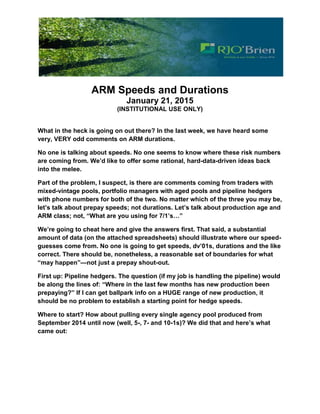
ARM Speed and Duration Data for Hedging Purposes
- 1. ARM Speeds and Durations January 21, 2015 (INSTITUTIONAL USE ONLY) What in the heck is going on out there? In the last week, we have heard some very, VERY odd comments on ARM durations. No one is talking about speeds. No one seems to know where these risk numbers are coming from. We’d like to offer some rational, hard-data-driven ideas back into the melee. Part of the problem, I suspect, is there are comments coming from traders with mixed-vintage pools, portfolio managers with aged pools and pipeline hedgers with phone numbers for both of the two. No matter which of the three you may be, let’s talk about prepay speeds; not durations. Let’s talk about production age and ARM class; not, “What are you using for 7/1’s…” We’re going to cheat here and give the answers first. That said, a substantial amount of data (on the attached spreadsheets) should illustrate where our speed- guesses come from. No one is going to get speeds, dv’01s, durations and the like correct. There should be, nonetheless, a reasonable set of boundaries for what “may happen”—not just a prepay shout-out. First up: Pipeline hedgers. The question (if my job is handling the pipeline) would be along the lines of: “Where in the last few months has new production been prepaying?” If I can get ballpark info on a HUGE range of new production, it should be no problem to establish a starting point for hedge speeds. Where to start? How about pulling every single agency pool produced from September 2014 until now (well, 5-, 7- and 10-1s)? We did that and here’s what came out:
- 2. The data to get all of the numbers in the pink boxes (above) is on the first three pages of the (attached) spreadsheet. Once Coupon/WAM/AvgPPay/Avg Price are established from very recent production, the risk numbers in the green boxes may be calculated. DON’T LET SOMEONE GIVE YOU DV’01 AND DURATION! GET THE INPUTS AND VERIFY THESE NUMBERS YOURSELF. USE OUR MORTGAGEbuilder SOFTWARE OR BLOOMBERG™ “BC35” CALCULATOR. Our program is easier and generates the proper hedge but, for the purpose of third- party neutrality, here’s Bloomberg’s output: So the risk numbers of dv’01 and duration may be calculated for all recent, like- kind, pools. That’s great, but there are nuances YOU know about your pipe and production that others may not. Perhaps your new issuance is coming from an HPA surge area. Maybe your AEs just got a new expresso machine and they are going to be pushing HARD for refi and recapture. Or maybe it’s the opposite of both. The first situation would likely push the pipeline hedge to re-run the risk at a 20% faster speed. Or, maybe you’d like to see where your recent production has been prepaying?-if you have pools trading from the last 4 months, we isolated each
- 3. servicer’s speed individually in the attached (look to the right of pool data for each ARM class). You also know something about those pools—were they “cherry picked” and the remainder sold or did your organization decide to go the other way and fill those pools with slower retail origination? The speed/performance data is out there. It will take a small effort to harness the information. Calling around and asking for others’ opinions will not, in any reasonable likelihood, get the correct answer. Then, there is the portfolio hedger—be it trader on an available-for-sale desk or a buy-hedge-hold manager. Portfolio speeds on seasoned ARMs do appear to be picking up. There is also the seasonal kicker where prepays tend to make their largest acceleration between January and July. In fact, speeds can jump by about 40% of their annual rate. ARMs that were originated with wide gross-versus-net spreads look to be under hard re-fi pressure. Most of you that fall into the “portfolio/seasoned” hedger have “prepayment specialists” on hand or who you pay as consultants. We absolutely have no interest trying to interrupt that process. For those hedgers that do not, we will offer a few projections on seasoned Freddie ARMs.
- 4. If you are hedging any of these pools or like-kind pools/loans vastly faster or slower, now would be a real good time to ask “am I sure?” We, the Fixed Income Group at RJO, are not and never will be “the prepay guys.” The last several business days have forced our hand. Successful hedging requires a starting point of rational prepayment estimates. Please look through the attached prepay data. Come to your own conclusions based on that data and what you have specific to your product. The tendency will be to guess faster; much faster. The data just isn’t there for new production. The data appears to be there for faster speeds for older vintages. More than anything, it is our hope that everybody challenges random prepayment numbers. Accept the speed opinion of others with an understanding that you (or ask us) will do the calculations. See the data—it’s all out there—and be comfortable that your hedge numbers make sense to you. Please see the attached workbook- JC (for the Fixed Income Group)
